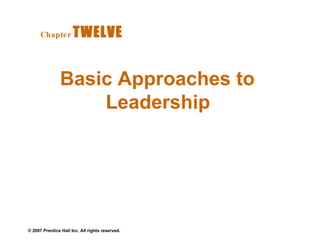Ob12 12st
•Télécharger en tant que PPT, PDF•
2 j'aime•3,286 vues
Signaler
Partager
Signaler
Partager

Recommandé
Contenu connexe
Tendances
Tendances (19)
Fielder Contingency theory of leadership by Hassan Samoon

Fielder Contingency theory of leadership by Hassan Samoon
Ongamo joe marshal - basic approaches to leadership

Ongamo joe marshal - basic approaches to leadership
Basic Approaches to Leadership, Chapter-12- Organizational Behavior

Basic Approaches to Leadership, Chapter-12- Organizational Behavior
En vedette
En vedette (14)
Social Constructivism & Cognitive Development Theory

Social Constructivism & Cognitive Development Theory
Similaire à Ob12 12st
Similaire à Ob12 12st (20)
Plus de Jal Pari
Plus de Jal Pari (18)
Dernier
APM Welcome
Tuesday 30 April 2024
APM North West Network Conference, Synergies Across Sectors
Presented by:
Professor Adam Boddison OBE, Chief Executive Officer, APM
Conference overview:
https://www.apm.org.uk/community/apm-north-west-branch-conference/
Content description:
APM welcome from CEO
The main conference objective was to promote the Project Management profession with interaction between project practitioners, APM Corporate members, current project management students, academia and all who have an interest in projects.APM Welcome, APM North West Network Conference, Synergies Across Sectors

APM Welcome, APM North West Network Conference, Synergies Across SectorsAssociation for Project Management
God is a creative God Gen 1:1. All that He created was “good”, could also be translated “beautiful”. God created man in His own image Gen 1:27. Maths helps us discover the beauty that God has created in His world and, in turn, create beautiful designs to serve and enrich the lives of others.
Explore beautiful and ugly buildings. Mathematics helps us create beautiful d...

Explore beautiful and ugly buildings. Mathematics helps us create beautiful d...christianmathematics
Dernier (20)
Kisan Call Centre - To harness potential of ICT in Agriculture by answer farm...

Kisan Call Centre - To harness potential of ICT in Agriculture by answer farm...
Beyond the EU: DORA and NIS 2 Directive's Global Impact

Beyond the EU: DORA and NIS 2 Directive's Global Impact
Presentation by Andreas Schleicher Tackling the School Absenteeism Crisis 30 ...

Presentation by Andreas Schleicher Tackling the School Absenteeism Crisis 30 ...
APM Welcome, APM North West Network Conference, Synergies Across Sectors

APM Welcome, APM North West Network Conference, Synergies Across Sectors
Explore beautiful and ugly buildings. Mathematics helps us create beautiful d...

Explore beautiful and ugly buildings. Mathematics helps us create beautiful d...
Z Score,T Score, Percential Rank and Box Plot Graph

Z Score,T Score, Percential Rank and Box Plot Graph
Call Girls in Dwarka Mor Delhi Contact Us 9654467111

Call Girls in Dwarka Mor Delhi Contact Us 9654467111
Disha NEET Physics Guide for classes 11 and 12.pdf

Disha NEET Physics Guide for classes 11 and 12.pdf
Ob12 12st
- 1. Basic Approaches to Leadership Chapter TWELVE
- 2. What Is Leadership? Leadership The ability to influence a group toward the achievement of goals. Management Use of authority inherent in designated formal rank to obtain compliance from organizational members.
- 8. Ohio State Studies Initiating Structure The extent to which a leader is likely to define and structure his or her role and those of sub-ordinates in the search for goal attainment. Consideration The extent to which a leader is likely to have job relationships characterized by mutual trust, respect for subordinate’s ideas, and regard for their feelings.
- 9. University of Michigan Studies Employee-Oriented Leader Emphasizing interpersonal relations; taking a personal interest in the needs of employees and accepting individual differences among members. Production-Oriented Leader One who emphasizes technical or task aspects of the job.
- 10. The Managerial Grid (Blake and Mouton) E X H I B I T 12 –1
- 13. Fiedler’s Model: The Leader Least Preferred Co-Worker (LPC) Questionnaire The way in which a leader will evaluate a co-worker that is not liked will indicate whether the leader is task- or relationship-oriented. Assumption: Leader’s Style is Fixed & Can be Measured by the Least Preferred Co-Worker (LPC) Questionnaire
- 14. Fiedler’s Model: Defining the Situation Leader-Member Relations The degree of confidence, trust, and respect subordinates have in their leader. Position Power Influence derived from one’s formal structural position in the organization; includes power to hire, fire, discipline, promote, and give salary increases. Task Structure The degree to which the job assignments are procedurized.
- 16. Findings from Fiedler Model E X H I B I T 12 –2
- 19. Hersey and Blanchard’s Situational Leadership Theory Situational Leadership Theory (SLT) A contingency theory that focuses on followers’ readiness; the more “ready” the followers (the more willing and able) the less the need for leader support and supervision. LOW Amount of Follower Readiness HIGH Amount of Leader Support & Supervision Required HIGH LOW
- 20. Leadership Styles and Follower Readiness (Hersey and Blanchard) Willing Unwilling Able Unable Directive High Task and Relationship Orientations Supportive Participative Monitoring Follower Readiness Leadership Styles
- 22. Leader-Member Exchange Theory E X H I B I T 12 –3
- 24. The Path-Goal Theory E X H I B I T 12 –4
- 29. © 2007 Prentice Hall Inc. All rights reserved. Chapter Check-Up: Leadership What one theory discussed in this chapter could readily explain how leaders often act towards their followers in “Boot Camp” and why it may be very effective? Hersey and Blanchard’s Situational Leadership Theory explains that when followers are unwilling and unable, as many newly enlisted Boot Camp attendees are, the leader should be highly focused on providing task-based behaviors and not relationship-based behaviors.
Notes de l'éditeur
- Fiedler asserts that if the leader’s style matches the situation, he or she will be effective. His model predicts that low-LPC, task motivated leaders will be effective in high and low situational control. High-LPC, relationship motivated leaders will be effective in moderate situational control. The Fiedler model has several practical implications for managers: Leaders must understand their style and the situation. Leaders should focus on changing the situation to match their style. A good relationship with followers can compensate for a lack of power. Leaders can compensate for task ambiguity through training and experience.
